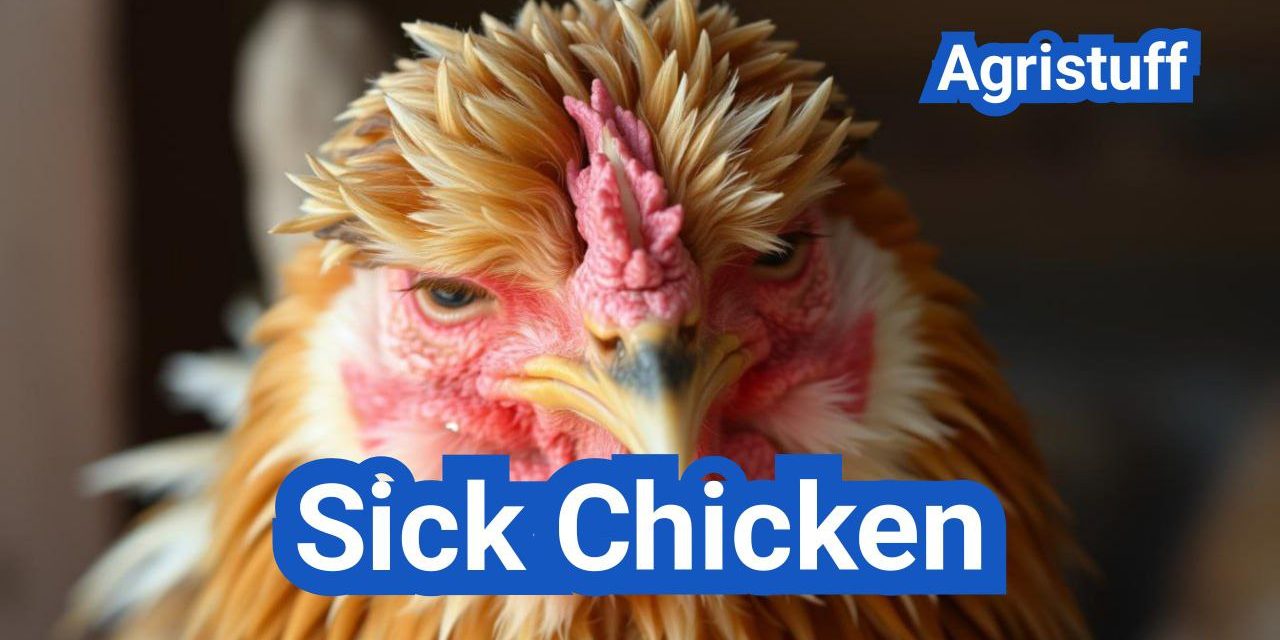Maintaining the health of your backyard chickens is crucial for their well-being and productivity. Recognizing the signs of illness in chickens is the first step towards providing appropriate care.
Identifying a sick chicken can be challenging, but it’s essential to detect health issues early to prevent the spread of disease within your flock. Common symptoms of chicken illness include changes in behavior, appetite, and physical condition.
Understanding how to care for a sick chicken is vital for any backyard chicken keeper. By knowing what to look for and how to respond, you can help your chickens recover and stay healthy.
Key Takeaways
- Recognizing early signs of illness in chickens is crucial for their care.
- Common symptoms include changes in behavior, appetite, and physical condition.
- Understanding chicken health helps in providing appropriate care.
- Early detection can prevent the spread of disease within your flock.
- Knowing how to care for a sick chicken is vital for backyard chicken keepers.
Understanding Chicken Health Basics
The foundation of successful chicken keeping lies in understanding the health and behavior of your flock. A healthy chicken is alert, active, and exhibits normal behavior for its breed and age.
What a Healthy Chicken Looks Like
A healthy chicken has bright, clear eyes, a smooth and shiny feather coat, and moves around with ease. Its comb and wattles should be a vibrant red color, indicating good health. Regular inspection of these physical attributes is crucial for early detection of any potential health issues.
Why Chickens Hide Illness
Chickens have a natural instinct to hide signs of illness or weakness, a trait inherited from their wild ancestors who were prey animals. This behavior helps them avoid appearing vulnerable to predators. As a result, it’s essential for chicken keepers to be vigilant and observant to detect any subtle changes in behavior or appearance that might indicate illness.
The Importance of Daily Observation
Daily observation is key to maintaining the health of your flock. By spending a few minutes each day observing your chickens’ behavior, appetite, and physical condition, you can identify potential health issues early on. This regular monitoring allows for timely intervention, which can significantly improve the chances of successful treatment and recovery.
Understanding these basics is fundamental to providing the best care for your chickens and ensuring the overall health and productivity of your flock.
Recognizing Sick Chicken Symptoms

Recognizing the symptoms of sick chickens is crucial for maintaining a healthy flock. Chickens can be prone to various illnesses, and early detection is key to effective treatment.
Physical Appearance Changes
Sick chickens often display noticeable changes in their physical appearance. These can include a hunched posture, ruffled feathers, or a generally disheveled look. Inspect your chickens regularly for signs such as:
- Watery eyes or discharge around the eyes and beak
- Dirty or discolored vent area
- Changes in comb color, such as pale or blueish tints
- Weight loss or reduced muscle tone
Behavioral Changes
Changes in behavior are also significant indicators of illness in chickens. Look out for:
- Lethargy or decreased activity
- Loss of appetite or reduced water intake
- Coughing, sneezing, or labored breathing
- Changes in egg-laying patterns or cessation of laying
Unusual Odors and Discharges
Unusual odors and discharges can be critical signs of infection or disease. Be aware of:
- Foul-smelling breath or discharges from the eyes, beak, or vent
- Abnormal droppings, such as diarrhea or unusually smelly feces
Monitoring these symptoms can help you identify sick chickens early. A table summarizing these signs is provided below for quick reference.
| Symptom Category | Specific Signs |
|---|---|
| Physical Appearance | Hunched posture, ruffled feathers, watery eyes, dirty vent |
| Behavioral Changes | Lethargy, loss of appetite, coughing, changes in egg laying |
| Unusual Odors and Discharges | Foul-smelling breath, abnormal droppings, discharges |
Common Poultry Diseases and Conditions
Understanding common poultry diseases is crucial for maintaining a healthy backyard flock. Poultry can be affected by a variety of health issues, ranging from respiratory problems to parasitic infections and viral diseases.
Respiratory Diseases
Respiratory diseases in chickens can be caused by bacterial infections, viruses, or mycoplasma infections. These conditions can lead to symptoms such as coughing, sneezing, and labored breathing. Early detection is key to managing and treating these diseases effectively.
- Infectious Bronchitis
- Mycoplasma Gallisepticum
- Avian Influenza
Parasitic Infections
Parasites can cause significant health issues in poultry, including coccidiosis, which is a major concern for many backyard chicken keepers. Coccidiosis can lead to symptoms like diarrhea, weight loss, and decreased egg production.
| Disease | Symptoms | Treatment |
|---|---|---|
| Coccidiosis | Diarrhea, Weight Loss | Anticoccidial Drugs |
| External Parasites (Mites, Lice) | Feather Loss, Anemia | Insecticides, Dusting Powders |
Viral Diseases
Viral diseases, such as Marek’s disease, can have a devastating impact on poultry flocks. Marek’s disease is a highly contagious viral condition that can cause tumors, paralysis, and death. Vaccination is a critical tool in preventing the spread of Marek’s disease.
Understanding and recognizing these common poultry diseases and conditions is essential for any backyard chicken keeper. By being aware of the symptoms and taking appropriate action, you can help maintain the health and productivity of your flock.
What To Do When You Have a Sick Chicken

Noticing a sick chicken in your flock demands swift response. If you have the slightest suspicion you have a sick chook, isolate her immediately. This initial step is crucial in preventing the spread of disease.
Immediate Response Steps
The first step in managing a sick chicken is to remove it from the rest of the flock to prevent disease transmission. Isolation is key in this initial response.
- Quickly and carefully catch the sick chicken to minimize stress.
- Move it to a separate, safe area away from the rest of the flock.
Setting Up a Quarantine Area
A quarantine area should be well-ventilated, dry, and free from drafts. Ensure it’s equipped with food, water, and any necessary medication.
Basic Assessment Techniques
Once isolated, assess the chicken’s condition. Look for signs of illness such as labored breathing, lethargy, or unusual droppings.
| Symptom | Possible Cause |
|---|---|
| Labored Breathing | Respiratory Infection |
| Lethargy | Viral or Bacterial Infection |
| Unusual Droppings | Digestive Issue or Infection |
Handling Sick Chicken Dinkum (Australian Approach)
The Australian approach to handling sick chickens, often referred to as “dinkum,” emphasizes genuine care and traditional methods. This includes using natural remedies and ensuring the chicken is handled gently and humanely.
Using a gentle, calm approach when handling sick chickens can significantly reduce their stress levels.
Treating Sick Chickens at Home
When treating sick chickens at home, it’s crucial to create an environment that fosters recovery. Keeping the bird hydrated is essential, and providing a quiet, warm, and safe environment can help the chicken recover.
Creating a Recovery Environment
A recovery environment is vital for a sick chicken’s health. This involves setting up a quiet, draft-free area with adequate ventilation. Ensure the space is warm, as sick chickens can quickly lose heat.
- Provide a clean, dry bed of straw or wood shavings.
- Keep the area free from drafts and extreme temperatures.
- Minimize stress by reducing noise and handling.
Administering Medications
Administering medications to sick chickens requires care and precision. Always follow the instructions provided with the medication, and consult a veterinarian if you’re unsure.
- Identify the correct medication for the illness.
- Follow the dosage instructions carefully.
- Monitor the chicken’s response to the medication.
Supportive Care Techniques
Supportive care is crucial for helping sick chickens recover. This includes ensuring they have access to fresh water and nutritious food.
Hydration is particularly important. You can offer electrolyte solutions to help replace lost salts.
Addressing Head Twitching and Neurological Signs
Head twitching and other neurological signs can be alarming. These symptoms may indicate a serious condition that requires veterinary attention.
- Monitor the chicken’s symptoms closely.
- Consult a veterinarian for a proper diagnosis.
- Follow the recommended treatment plan.
Nutrition for Sick Chickens

Nutrition plays a pivotal role in the health of sick chickens, and providing the right foods can significantly impact their recovery process. A well-balanced diet tailored to their specific needs during illness can help bolster their immune system and support their return to health.
Best Foods for Recovery
When chickens are sick, it’s essential to provide them with nutrient-rich foods that are easy to digest. Some of the best options include:
- Oats: A easily digestible grain that provides necessary carbohydrates.
- Plain Yogurt: Contains probiotics that can help maintain a healthy gut.
- Boiled Eggs: Rich in protein, which is crucial for recovery.
- Mashed Sweet Potatoes: Easy to digest and rich in vitamins and minerals.
Liquid Nutrition Options
In some cases, sick chickens may have difficulty consuming solid foods. Liquid nutrition can be a valuable alternative, providing essential nutrients without the need for digestion.
- Electrolyte Supplements: Can help rebalance lost electrolytes.
- Poultry Electrolyte Solutions: Specifically designed for chickens.
Hydration Solutions
Hydration is critical for sick chickens, as dehydration can quickly exacerbate their condition. Providing fresh, clean water is paramount, and in some cases, adding hydration supplements can be beneficial.
Supplements and Probiotics
Supplements and probiotics can play a crucial role in supporting the health of sick chickens. Probiotics help maintain a healthy gut microbiome, while certain supplements can provide additional nutrients that may be lacking in their diet.
| Supplement | Benefit |
|---|---|
| Probiotics | Supports gut health |
| Vitamin A | Boosts immune system |
| Calcium | Essential for bone health |
By focusing on the right nutrition, you can significantly improve the chances of recovery for your sick chickens. Always consult with a veterinarian to determine the best nutritional plan tailored to the specific needs of your flock.
Natural Remedies for Sick Chicken Treatment

Natural remedies can play a significant role in supporting the recovery of sick chickens, offering a gentler alternative to pharmaceuticals. These remedies can be used in conjunction with proper veterinary care to help alleviate symptoms and promote overall health.
Herbal Supplements and Their Benefits
Herbal supplements have been used for centuries to treat various ailments in poultry. Some beneficial herbs for chickens include:
- Echinacea – Known for its immune-boosting properties.
- Garlic – Acts as a natural antibiotic and immune system supporter.
- Turmeric – Contains curcumin, which has anti-inflammatory properties.
These herbs can be administered in various forms, such as dried herbs mixed into feed or as a tea infusion added to drinking water.
Apple Cider Vinegar Treatments
Apple cider vinegar is a popular natural remedy for chickens due to its potential health benefits, including:
- Aiding digestion
- Reducing the presence of harmful bacteria
- Supporting immune function
To use apple cider vinegar, mix 1 tablespoon with 1 gallon of drinking water. However, it’s crucial to use it in moderation to avoid upsetting the chicken’s digestive system.
Garlic and Other Immune Boosters
Garlic is not only a natural antibiotic but also a potent immune booster. It can be given to chickens by:
- Mixing minced garlic into their feed
- Adding garlic powder to their water
Other immune boosters include oregano and ginger, which can be used similarly to garlic.
Effective Homemade Electrolyte Solutions
Electrolyte imbalances can occur in chickens due to dehydration or illness. A homemade electrolyte solution can be made by mixing:
| Ingredient | Amount |
|---|---|
| Water | 1 quart |
| Table salt | 1 teaspoon |
| Baking soda | 1/4 teaspoon |
| Lite salt (or potassium chloride) | 1/4 teaspoon |
| Glucose (or dextrose) | 2 tablespoons |
This solution can help replenish lost electrolytes and support the chicken’s recovery.
When to Seek Veterinary Help

Seeking veterinary help at the right moment can significantly improve your chicken’s chances of recovery. While many chicken owners can treat common ailments at home, some situations require professional expertise.
Finding an Avian Veterinarian
The first step in seeking veterinary help is finding a qualified avian veterinarian. Not all veterinarians specialize in poultry care, so it’s essential to find one with experience in treating chickens. You can start by asking for recommendations from local poultry groups or checking online directories.
Once you have a list of potential veterinarians, consider factors such as their proximity to your location, availability for emergency calls, and their approach to chicken care. Establishing a relationship with a veterinarian before you need their services can be incredibly valuable.
Emergency Symptoms That Require Immediate Care
Some symptoms indicate that your chicken needs immediate veterinary attention. These include:
- Severe difficulty breathing
- Profuse bleeding or discharge
- Severe lethargy or loss of consciousness
- Sudden changes in behavior or drooping wings
If you observe any of these emergency symptoms, do not hesitate to seek veterinary help immediately. Prompt action can be the difference between life and death for your chicken.
What to Expect During a Vet Visit
During a vet visit, the avian veterinarian will conduct a thorough examination of your chicken. This may include:
- Physical examination
- Laboratory tests (such as blood work or cultures)
- Imaging studies (like X-rays)
The veterinarian will then provide a diagnosis and recommend a treatment plan. It’s crucial to follow their advice closely to ensure the best possible outcome for your chicken.
When Antibiotics Are Necessary
Antibiotics are effective against bacterial infections but are not suitable for viral diseases. Your veterinarian will determine if antibiotics are necessary based on the diagnosis. If prescribed, it’s essential to complete the full course of antibiotics as directed to prevent the development of antibiotic-resistant bacteria.
In conclusion, knowing when to seek veterinary help is a critical aspect of chicken care. By understanding the signs that indicate the need for professional help and knowing how to find a qualified avian veterinarian, you can ensure your chicken receives the care it needs to recover from illness.
Preventing Poultry Diseases

Keeping your chickens healthy requires a comprehensive strategy that includes disease prevention measures. Preventing poultry diseases is a multi-faceted approach that involves understanding the health needs of your flock and implementing practices that minimize the risk of disease.
Vaccination Schedules
Vaccination is a critical component of a disease prevention strategy. Establishing a vaccination schedule with the help of a veterinarian can protect your flock from common poultry diseases. Vaccines are available for various diseases, including Newcastle disease and infectious bronchitis. It’s essential to follow a vaccination schedule that is tailored to the specific needs of your flock, taking into account factors such as age, health status, and the prevalence of certain diseases in your area.
- Consult with an avian veterinarian to determine the best vaccination schedule.
- Keep accurate records of vaccinations administered to your flock.
- Monitor your flock’s health closely after vaccination to identify any adverse reactions.
Coop Sanitation Practices
Maintaining a clean coop is fundamental to preventing the spread of diseases. Regular cleaning and disinfection can significantly reduce the risk of disease transmission. Remove soiled bedding, clean feeders and waterers, and disinfect all surfaces regularly. Ensuring good ventilation in the coop is also crucial, as it helps to remove moisture and reduce the concentration of airborne pathogens.
- Remove soiled bedding material weekly.
- Clean and disinfect feeders and waterers daily.
- Inspect the coop regularly for signs of disease or pests.
Feed and Water Management
Proper feed and water management is vital for maintaining the health of your flock. Ensure that feed is stored in a dry, rodent-proof area to prevent contamination. Waterers should be cleaned daily, and water should be fresh and free from contamination. Consider using a water treatment product to help control bacteria and other pathogens in the water.
- Store feed in a clean, dry area.
- Use feeders that minimize spillage and waste.
- Provide fresh, clean water at all times.
By implementing these disease prevention strategies, you can significantly reduce the risk of disease in your flock, ensuring they remain healthy and thrive.
Implementing Poultry Biosecurity

Poultry biosecurity is a critical aspect of maintaining a healthy flock and preventing disease outbreaks. It involves a set of measures designed to protect your chickens from diseases and infections. Effective biosecurity is not just about keeping your chickens healthy; it’s also about preventing the spread of diseases to other birds and even to humans in some cases.
Quarantine Procedures for New Chickens
Introducing new chickens to your flock can be risky if not done properly. Quarantine procedures are essential to ensure that new birds are healthy before they join your existing flock. A quarantine period of at least 30 days is recommended, during which the new birds should be kept isolated and monitored for any signs of illness.
During quarantine, it’s crucial to:
- Keep the new birds in a separate enclosure away from your main flock.
- Use dedicated equipment for the quarantined birds that is not shared with the rest of your flock.
- Monitor the new birds daily for any signs of illness or stress.
Visitor and Equipment Protocols
Visitors can unintentionally bring diseases into your flock on their clothing or equipment. Establishing visitor and equipment protocols can help mitigate this risk. This includes:
- Limiting access to your coop and run.
- Providing disposable coveralls or boot dips for visitors.
- Ensuring all equipment is cleaned and disinfected before it enters the coop or run.
Predator and Wild Bird Management
Predators and wild birds can be carriers of diseases. Implementing measures to manage these risks is crucial. This includes:
- Securing your coop and run to prevent predator entry.
- Using netting or other deterrents to keep wild birds away.
- Removing any attractants that might draw wild birds to your coop, such as feed spills.
Proper Disposal of Sick or Dead Birds
The disposal of sick or dead birds is a critical aspect of biosecurity. Improper disposal can lead to the spread of disease. It’s essential to:
- Bury dead birds deep enough to prevent scavengers from uncovering them.
- Burn or properly dispose of carcasses according to local regulations.
- Disinfect any areas where the dead or sick birds were kept.
Effective poultry biosecurity requires a multi-faceted approach. The following table summarizes key biosecurity measures:
| Biosecurity Measure | Description | Importance |
|---|---|---|
| Quarantine New Birds | Isolate new birds for 30 days before introducing them to the flock. | High |
| Visitor Protocols | Limit access and provide protective gear for visitors. | Medium |
| Equipment Disinfection | Clean and disinfect all equipment before use in the coop or run. | High |
| Predator and Wild Bird Control | Secure the coop and run, and deter wild birds. | High |
By implementing these biosecurity measures, you can significantly reduce the risk of disease in your flock, ensuring a healthier and more productive poultry-keeping experience.
Seasonal Backyard Chicken Health Concerns

Seasonal changes can significantly impact the health and well-being of backyard chickens, making it crucial for owners to understand and mitigate these effects.
Summer Heat Stress Management
Summer brings the risk of heat stress, a potentially life-threatening condition for chickens. To manage heat stress, ensure your coop is well-ventilated and provide plenty of cool water and shade.
Key Strategies for Reducing Heat Stress:
- Provide cool water and electrolyte supplements
- Ensure adequate ventilation in the coop
- Offer shaded areas for chickens to escape direct sunlight
Winter Health Challenges
Winter poses its own set of challenges, including cold stress and the potential for frostbite. Maintaining a dry and draft-free coop is essential.
Tips for Winter Care:
- Insulate the coop without compromising ventilation
- Monitor for signs of cold stress
- Provide extra nutrition to help chickens stay warm
Spring and Fall Transition Care
During the spring and fall, chickens undergo transition periods that can affect their health. It’s crucial to adjust their care accordingly.
“The transition periods of spring and fall require careful management to prevent health issues in backyard chickens.”
Seasonal Parasite Control
Parasites can be a significant issue throughout the year, but certain seasons can exacerbate the problem. Implementing a parasite control program is vital.
| Season | Common Parasites | Control Measures |
|---|---|---|
| Spring | Mites, Lice | Dust baths, coop cleaning |
| Summer | Flies, Mites | Fly traps, mite powders |
| Fall/Winter | Lice, Internal Parasites | Medicated feed, coop sanitation |
Reporting Requirements and Resources

Reporting sick birds is not just a regulatory requirement; it’s a vital measure for maintaining poultry health. As a backyard chicken owner, understanding when and how to report sick or dead birds can help prevent the spread of disease and protect your flock.
When to Report Sick Birds to USDA
The USDA requires reporting of certain poultry diseases that could have a significant impact on the poultry industry. If you suspect that your birds are infected with a highly contagious or reportable disease, such as Avian Influenza or Newcastle Disease, you must notify the USDA immediately.
To report sick or dead birds, you can contact your local USDA office or use the USDA’s online reporting tool. It’s crucial to provide as much detail as possible about the symptoms and number of birds affected.
State-Specific Regulations
In addition to federal reporting requirements, each state may have its own regulations regarding the reporting of poultry diseases. It’s essential to familiarize yourself with your state’s specific rules to ensure compliance.
For example, some states require reporting of certain diseases to the state veterinarian’s office. You can find more information on state-specific regulations by contacting your local animal health department or visiting their website.
Helpful Resources for Backyard Flock Owners
Backyard flock owners can benefit from various resources to help manage and maintain the health of their poultry. These include:
- Local poultry associations and clubs
- Online forums and communities dedicated to backyard chicken keeping
- Educational materials and workshops provided by universities or extension offices
Joining Poultry Health Communities
Joining poultry health communities can provide valuable support and information for backyard flock owners. These communities often share best practices, discuss disease management, and offer advice on maintaining flock health.
By engaging with these communities, you can stay informed about the latest developments in poultry health and contribute to the collective effort to prevent disease outbreaks.
At The End of: Sick Chicken Care
By following the guidance outlined in this article, backyard chicken owners can help keep their flocks healthy and thriving. Effective sick chicken care involves understanding chicken health basics, recognizing symptoms of illness, and providing appropriate treatment and care.
Maintaining poultry health requires a comprehensive approach, including daily observation, nutrition, and biosecurity measures. By implementing these strategies, chicken owners can reduce the risk of disease and ensure the well-being of their flock.
In conclusion, caring for sick chickens requires attention to detail, a understanding of poultry health, and a commitment to providing quality care. By following the tips and guidelines outlined in this article, backyard chicken owners can help their flock recover from illness and maintain overall health.
FAQ
How do I know if my chicken is sick?
Look for changes in physical appearance, behavior, and unusual odors or discharges. Common signs include discoloration of the comb, decreased egg production, sudden weight loss, and difficulty breathing.
What are the common symptoms of sick chickens?
Common symptoms include physical appearance changes, behavioral changes, unusual odors and discharges, decreased egg production, sudden weight loss, and difficulty breathing.
Why do chickens hide illness?
Chickens hide illness as a natural instinct to avoid being targeted by predators. This makes it crucial to observe your flock daily to catch any signs of illness early.
What should I do when I have a sick chicken?
Isolate the sick chicken, assess the situation, provide warmth, nutritious food, and hydration. Consult a veterinarian if necessary, and follow proper quarantine and biosecurity measures.
How can I treat sick chickens at home?
Create a recovery environment, administer medications as prescribed, and provide supportive care techniques such as nutritional supplements and hydration solutions.
What are the best foods for sick chickens?
Provide easily digestible foods, such as scrambled eggs, plain yogurt, and oatmeal. You can also offer liquid nutrition options like chicken broth or electrolyte-rich drinks.
Can I use natural remedies to treat sick chickens?
Yes, natural remedies like herbal supplements, apple cider vinegar treatments, and garlic can be used to support chicken health. However, always consult a veterinarian before using any new treatments.
When should I seek veterinary help for my sick chicken?
Seek veterinary help if your chicken shows emergency symptoms, such as difficulty breathing, severe lethargy, or if you’re unsure of the diagnosis or treatment.
How can I prevent poultry diseases?
Implement vaccination schedules, maintain coop sanitation practices, manage feed and water quality, and follow biosecurity measures to prevent disease.
What are the key biosecurity measures for backyard chickens?
Implement quarantine procedures for new chickens, visitor and equipment protocols, and predator and wild bird management to maintain biosecurity.
How do I manage seasonal health concerns for my backyard chickens?
Manage summer heat stress with cooling measures, winter health challenges with proper ventilation and nutrition, and provide transition care during spring and fall.
When should I report sick birds to the USDA?
Report sick birds to the USDA if you suspect a reportable disease, such as a highly contagious or zoonotic disease. Check state-specific regulations for additional reporting requirements.
Where can I find helpful resources for backyard flock owners?
Consult local poultry associations, extension offices, and online resources for guidance on backyard chicken health, disease management, and biosecurity measures.
Conclusion of: Sick Chicken Care
Why Fast Action Matters for a Sick Chicken
A Sick Chicken can deteriorate rapidly because birds hide illness to avoid flock aggression, so what looks “mild” at breakfast can be an emergency by sunset. Early recognition, isolation, and biosecurity are the three pillars that stop one Sick Chicken from turning into a flock-wide outbreak. The sooner you act, the more options you have for treatment and recovery, and the lower your overall losses in eggs, growth, and bird welfare. USDA APHIS – Know the signs of illness.
Core Signs You Can Spot Quickly in a Sick Chicken
Classic clues of a Sick Chicken include lethargy, sitting away from flock mates, reduced feed or water intake, ruffled feathers, pale comb, diarrhea, sneezing, coughing, labored breathing (rales), eye or nasal discharge, and sudden egg drop. If you see two or more signs together, assume you’re dealing with a Sick Chicken and check the rest of the flock methodically for similar symptoms. Poultry Extension – Common signs of illness.
Behavior Changes: The Earliest Red Flags of a Sick Chicken
Before obvious symptoms, a Sick Chicken often shows “sickness behaviors”: hunching, drooped wings, half-closed eyes, unusual quietness, or isolating under a low perch. These behaviors are survival strategies in prey species, which is why careful daily observation spots a Sick Chicken hours to days earlier than a casual glance. University of Maryland Extension – Sickness behavior.
Immediate First Steps When You Notice a Sick Chicken
Isolate the Sick Chicken in a clean, well-ventilated pen with its own feeder and waterer; handle it last; change or disinfect footwear and tools; and wash hands after contact. These simple moves limit pathogen spread while you assess hydration, temperature exposure, and feed intake for the isolated Sick Chicken. USDA APHIS – Defend the Flock biosecurity resources.
When to Report a Sick Chicken Immediately
If your Sick Chicken shows neurologic signs, purple/blue comb, sudden death, or if multiple birds are ill at once, call your state vet or USDA right away. Rapid reporting protects neighbors and helps you access testing and official guidance for your Sick Chicken. USDA APHIS – Report sick birds (1-866-536-7593).
Avian Influenza: Why a Sick Chicken Can Be an Emergency
Highly Pathogenic Avian Influenza (HPAI) can cause sudden death, severe depression, swelling or purple comb/wattles, respiratory distress, and egg drop, so treat any Sick Chicken with these signs as urgent. Strict isolation, zero sharing of equipment, and prompt reporting reduce risk for every Sick Chicken and the rest of your flock. USDA APHIS – AI warning signs.
Track the National Situation to Protect a Sick Chicken
Outbreaks ebb and flow by season and region, so check recent detections to understand current risk around a Sick Chicken. If your county or neighboring counties report cases, tighten biosecurity and reconsider shows/sales until your Sick Chicken and flock are in the clear. USDA APHIS – HPAI detections.
Heat Stress vs. Disease: Not Every Sick Chicken Has an Infection
Summer panting, wings held away from the body, and droopy posture can reflect heat stress rather than infection in a Sick Chicken. Offer shade, airflow, cool water, and wet down runs (without creating mud) to bring core temperature down for the Sick Chicken fast. University of Minnesota Extension – Preventing heat stress.
Electrolytes and Water Intake for a Heat-Stressed Sick Chicken
Short-term electrolytes (up to 72 hours) can support hydration in a heat-stressed Sick Chicken. Start before peak afternoon heat and refresh water often; then return to plain water to avoid imbalances as the Sick Chicken recovers. UMN Extension – Electrolyte guidance.
Respiratory Illness: What Coughs and Sneezes Mean in a Sick Chicken
Watery eyes, swollen eyelids, nasal discharge, and rales point to a respiratory disease in a Sick Chicken. Because similar signs can come from different pathogens, get veterinary guidance on testing and control measures for your Sick Chicken. Penn State Extension – Respiratory diseases in small flocks.
Infectious Laryngotracheitis (ILT) in a Sick Chicken
Blood-tinged mucus, gasping, and coughing are classic for ILT, a contagious herpesvirus that can circulate after shows or bird trades and affect a Sick Chicken severely. Control depends on biosecurity, vaccination policies, and minimizing stress for the Sick Chicken. Penn State Extension – ILT in poultry.
Coccidiosis: A Common Digestive Threat to a Sick Chicken
Orange or bloody droppings, dehydration, weight loss, and listlessness suggest coccidiosis, especially in chicks, and can quickly weaken a Sick Chicken. Dry litter, prompt treatment per label/vet advice, and avoiding wet, dirty areas are critical for a recovering Sick Chicken. UC ANR – Coccidiosis in chickens (PDF).
Prevention and Treatment Basics for a Sick Chicken With Coccidiosis
Vaccination at hatch or strategic anticoccidials reduce risk long-term, but accurate dosing and timing matter for a Sick Chicken. Because the parasite damages the gut lining, supportive hydration and easily digestible feed help the Sick Chicken regain condition. Merck Veterinary Manual – Coccidiosis overview.
Marek’s Disease: When Paralysis or Wasting Appears in a Sick Chicken
Leg or wing paralysis, weight loss, and enlarged nerves can indicate Marek’s disease in a Sick Chicken. There is no cure once clinical signs appear, which is why prevention through hatch-day vaccination is vital for avoiding a future Sick Chicken. Merck Veterinary Manual – Marek’s disease.
Marek’s Vaccination Strategy to Reduce Sick Chicken Cases
Most hatcheries can vaccinate day-old chicks; then keep them separate from older birds for several days so immunity develops, helping you avoid another Sick Chicken. This is especially important if you attend shows or swap birds, which increases exposure and the chance of a Sick Chicken. Penn State Extension – Marek’s disease and vaccination.
External Parasites: Mites and Lice Can Make a Chicken Sick
Heavy external parasites lead to anemia, irritation, weight loss, and egg decline, turning a normal layer into a Sick Chicken. Inspect at night with a flashlight—check the vent, under wings, and skin for moving mites/lice or egg clusters to confirm a Sick Chicken case. UF/IFAS – Northern fowl mite impacts.
Treating Mites and Lice to Help a Sick Chicken Recover
Follow label directions for approved products, repeat on schedule to match life cycles, and clean/disinfect roosts and nest boxes so the Sick Chicken isn’t re-infested. Treat all birds, not just the obviously Sick Chicken, to break the cycle. University of Kentucky – Common external parasites (PDF).
Internal Parasites: Deworming Decisions for a Sick Chicken
Weight loss, poor feathering, and diarrhea may indicate internal parasites in a Sick Chicken. A fecal exam via a veterinarian or diagnostic lab confirms species and guides safe, effective treatment plans tailored to your Sick Chicken. UNH Extension – Internal parasites in chickens (PDF).
Drug Rules: Keep Your Sick Chicken Safe—and Eggs Legal
Extra-label drug use is allowed only under a veterinarian’s supervision in the U.S.; some drugs are banned in poultry. Always document egg/meat withdrawal times for a Sick Chicken receiving medication and keep records. FDA – AMDUCA (extra-label drug use).
Medications You Must Avoid for a Sick Chicken
Certain compounds are prohibited in food animals because of residue risks, so never give a Sick Chicken any medication without checking its legal status. Your vet or FARAD can verify safety and compliance before treating a Sick Chicken. FARAD – Prohibited & restricted drugs.
Supportive Care That Helps Any Sick Chicken Recover
Quiet housing, easy access to fresh water and feed, appropriate temperature (warmth in cold snaps, cooling in heat), and low stress accelerate recovery for a Sick Chicken. Clean and disinfect equipment to prevent reinfection while you monitor the Sick Chicken daily. Iowa State Extension – Backyard biosecurity tips.
Quarantine New or Returning Birds to Prevent a Sick Chicken
Keep new arrivals or birds returning from shows isolated for at least 30 days to stop hidden pathogens from creating a Sick Chicken in your main coop. Separate airspace and dedicated tools are best for avoiding a future Sick Chicken. UMN Extension – AI basics & 30-day quarantine.
Daily Biosecurity Habits That Keep a Sick Chicken Rare
Limit visitors, wash hands, keep a dedicated pair of coop boots, cover feed, fence out wild birds, and store poultry gear outside the home so one Sick Chicken doesn’t turn into ten. Teach children to handle birds safely and wash after touching a Sick Chicken. CDC – Backyard poultry hygiene & Salmonella.
Protect Yourself When Caring for a Sick Chicken
Even healthy birds can shed Salmonella and other germs; wear gloves for wound care, avoid kissing birds, and keep poultry out of kitchens—especially when nursing a Sick Chicken. These habits protect your family as you rehabilitate a Sick Chicken. CDC – Advice for backyard poultry owners.
When to Use a Diagnostic Lab for a Sick Chicken
If a Sick Chicken dies or several birds fall ill, submit a bird for necropsy to identify the exact cause (PCR, cultures, histopath). Confirmation guides targeted prevention so the next Sick Chicken never happens. Cornell AHDC – Avian Health Program.
National Lab Support for Sick Chicken Investigations
During outbreaks, your veterinarian may coordinate with federal labs for specialized testing that clarifies what’s affecting a Sick Chicken. Ask where to ship samples and how to handle carcasses to preserve results for the Sick Chicken workup. USDA APHIS – National Veterinary Services Laboratories.
Final Thought
Catching a Sick Chicken early—then isolating, observing, and using science-based care—turns a crisis into a manageable farm task. Layer in vaccination, strong sanitation, and legal, vet-guided treatments, and you’ll prevent many future Sick Chicken events across seasons. USDA APHIS – Defend the Flock resources.
Sources & References
The following trusted references support every recommendation for recognizing, treating, and preventing a Sick Chicken in U.S. backyard and small farm settings. Poultry Extension – Main portal.
- USDA APHIS – Signs of illness & reporting
- USDA APHIS – HPAI detections
- University of Minnesota Extension – Preventing heat stress
- Poultry Extension – Common signs of illness
- Penn State Extension – Respiratory diseases
- Penn State Extension – ILT in poultry
- UC ANR – Coccidiosis in chickens (PDF)
- Merck Veterinary Manual – Coccidiosis
- Merck Veterinary Manual – Marek’s disease
- Penn State Extension – Marek’s disease & vaccination
- UF/IFAS – Northern fowl mite
- University of Kentucky – External parasites (PDF)
- UNH Extension – Internal parasites (PDF)
- FDA – AMDUCA (extra-label use)
- FARAD – Prohibited & restricted drugs
- Iowa State Extension – Backyard biosecurity
- UMN Extension – AI basics & quarantine
- CDC – Backyard poultry hygiene & Salmonella
- Cornell AHDC – Avian Health Program
- USDA APHIS – National Veterinary Services Laboratories










